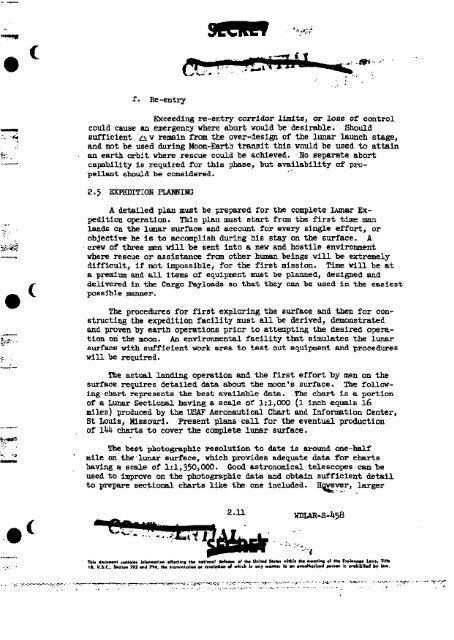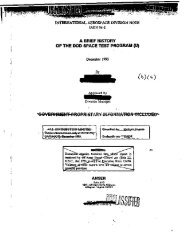LUNAR EXPEDITION PLAN
LUNAR EXPEDITION PLAN
LUNAR EXPEDITION PLAN
Create successful ePaper yourself
Turn your PDF publications into a flip-book with our unique Google optimized e-Paper software.
f. Re-entry<br />
•Vr-F<br />
. : • * & •<br />
Exceeding re-entry corridor lljnits, or IOBS of control<br />
could cause an emergency where abort would be desirable. Should<br />
sufficient Zi.v remain from the over-design of the lunar launch stage,<br />
and not he used during Moon-Earth transit this vould he used to attain<br />
an earth orbit where rescue could be achieved. Ho separate abort<br />
capability is required for this phase, hut availability of propellant<br />
should be considered.<br />
2.5 <strong>EXPEDITION</strong> PLAHNIHG<br />
A detailed plan must be prepared for the complete Lunar Expedition<br />
operation. This plan must start from the first time man<br />
lands on the lunar surface and account for every single effort, or<br />
objective he is to accomplish during his stay on the surface, A<br />
crew of three nien will be sent into a new and hostile environment<br />
where rescue or assistance from other human beings will be extremely<br />
difficult, if not impossible, for the first mission. Time will be at<br />
a premium and all items of equipment must be planned, designed and<br />
delivered in the Cargo Payloads so that they can be used in the easiest<br />
possible manner.<br />
The procedures for first exploring the surface and then for constructing<br />
the expedition facility must all be derived, demonstrated<br />
and proven by earth operations prior to attempting the desired operation<br />
oh the moon. An environmental facility that simulates the lunar<br />
surface with sufficient Work area to test out equipment and procedures<br />
will be required.<br />
The actual landing operation and the first effort by men on the<br />
surface requires detailed data about the moon's surface. The following<br />
chart represents the best available data. The chart is a portion<br />
of a Lunar Sectional having a scale of 1:1,000 (l inch equals 16<br />
miles) produced by the USAF Aeronautical Chart and Information Center,<br />
St Louis, Missouri. Present plans call for the eventual production<br />
of lUh charts to cover the complete lunar surface.<br />
The best photographic resolution to date is around one-half<br />
mile on the lunar surface, which provides adequate data for charts<br />
having a scale of 1:1,350,000, Good astronomical telescopes can be<br />
used to Improve on the photographic data and obtain sufficient detail<br />
to prepare sectional charts like the one included. However, larger<br />
2>li TOLAR-S-I*58<br />
TMi dnMil csnlahH iMwnirtlMi affecting tfc. nMtwst M » n af tto Unltad Slam VMIR It* attonlna al Hm iipioma** lo-i. TiH.<br />
II, U.S.C.. Sxiivn 7SJ mi 79*. MM Iroitiniilian ar mvalolian •! ""I** I" a"* ••»»» to •» IHwMatlod panan i. prafcifattod fcr la*.<br />
-»!-' -^.:-




